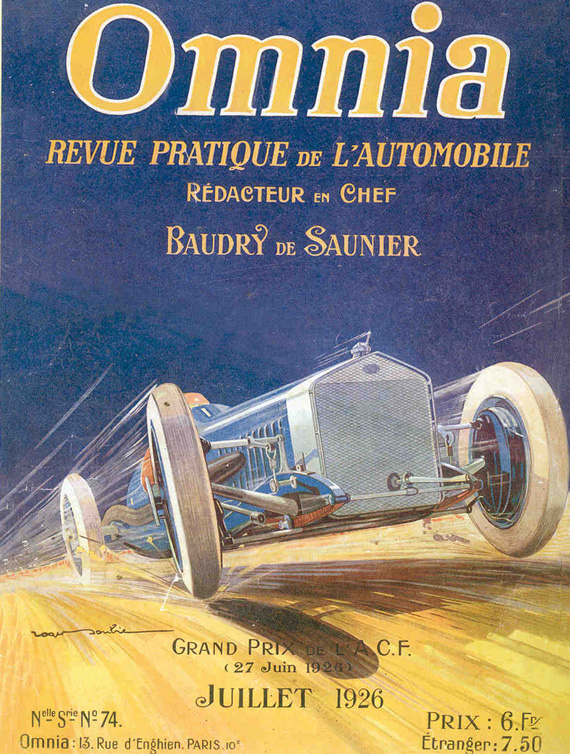By Pete Vack
Read Part I
All images are from the book “Delage, France’s Finest Car”
The Great War came and went, and the fortunes of Louis Delage increased manifold as the factory turned out bullets. A failure to ensure munitions quality which caused a scandal. After the devasting war profiteering became an issue, and the French government would argue over how to tax excess war profits until the start of World War II.
A significant post war move was to fire chief engineer Michelat and replace him with Charles Planchon. Delage, never one to look back, decided the post war era was ripe for larger four and six cylinder cars; he was half right, as the 6 cylinder CO model was not selling, but the four cylinder DO did better in the still depressed 1919-1920 economy. The CO model, despite lackluster sales, was quite a car; it had four wheel brakes, the 6 cylinder 4524 cc engine put out 68 hp and was in unit with a multi-plate clutch and four speed transmission connecting to a rear drive via two universal joints. The rear end was supported by semi-elliptic springs and shocks.
Always a bit of a showman, Delage himself embarked upon a series of whirlwind drives through France with the latest CO model Delage. The first was on September 12th, 1919, when he drove from Paris to Nice, a distance of 621 miles, in 15 hours 55 minutes. The much heralded express train took 21 hours.
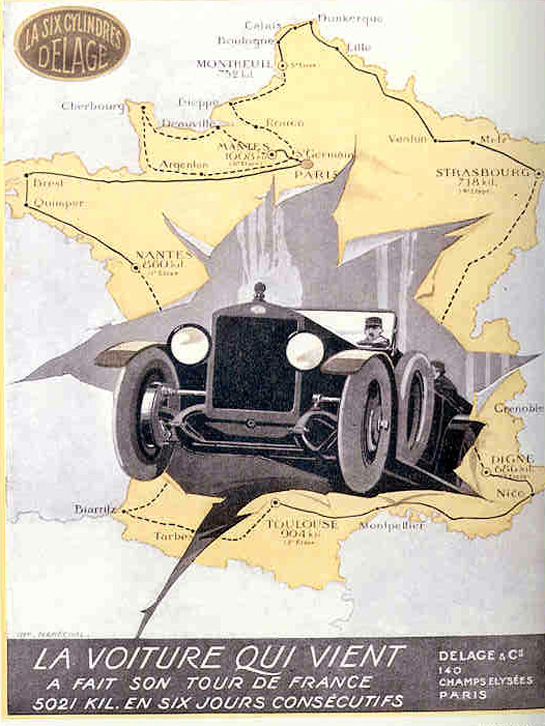
Delage was quick to publicize his ventures with the new CO. This ad portrays his six day Tour de France.
The next year he did a complete “Tour de France” with a CO model, and the 3120 mile lap of France took just over six days. His son Pierre followed suit with a tour of Spain. Unusual behavior for a CEO, but Delage not only gained publicity but made good use road testing the cars as well.
Quality is Job One
The emphasis on quality continued. As the authors duly noted; “The [Delage] cast aluminum crankcase was damascened [engine turned–ed.] by hand, the cylinder block and valve cover were finished in black enamel, the dashboard and instrument panel were also damascened by hand, the control rod for the carburetor and ignition were nickel plated, the radiator was polished silver, and so the list went on”.
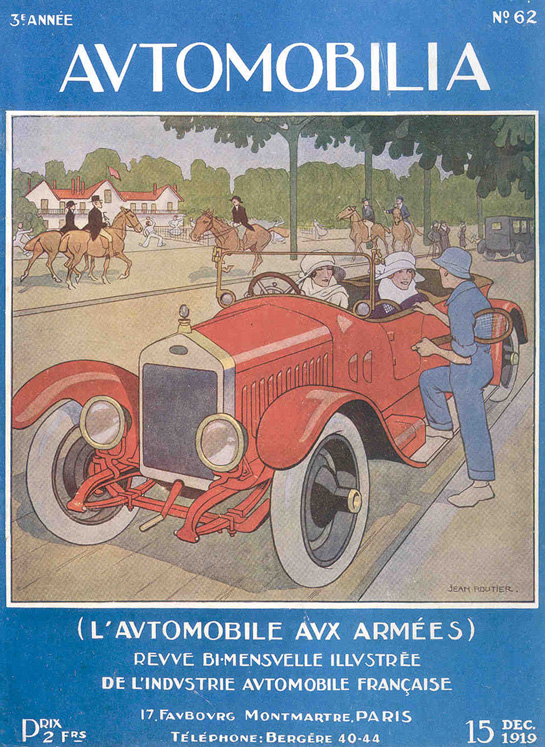
Nothing captured the immediate post-war period like the magazines of the era. Automobilia presents a colorful scene with a small Delage as the subject
Delages with four, six and eight cylinders
Throughout the 1920s, Delage produced six and four cylinder cars, the DE-DI range of fours being most predominant, with over 13,000 DO, DE and DI models produced. The six cylinder CO after only 1540 cars built was replaced by the DM-DR models from 1926 to 1929.
Finally, when things were looking good again, Delage returned to his dream of an eight cylinder luxury car, which was designated the D8. However, the D8 did not see production until late in 1929. The high prices of the luxury cars Delage was producing combined with the Depression would put Delage at the mercy of the banks by 1933. Between 1928 and 1935, only 1900 D8s in all forms were built.
But the twenties were not yet over, and the new engineer, Charles Planchon, was busy designing new race cars.
Delage V12 2 LCV
Planchon designed a 2 liter unsupercharged V12 for the new Grand Prix formula, which none too smartly, also allowed 2 liter supercharged cars in the same class. In 1923, this fantastic Gran Prix car suffered from cooling problems, and failed to win an event. Planchon, though related to Delage,was fired and Albert Lory was left to refine the V12 2 LCV.
Readers may be familiar with the 1924 Lyon Grand Prix, where Bugatti introduced the fabled Type 35, another unblown car. But it was the V12 Delage that not only was the star of the race, but finished second and third to the supercharged Alfa P2 of Campari. The tiny V12, with pistons only 1.67 inches in diameter, was also viewed with great interest by a young Enzo Ferrari who was driving the fourth Alfa Romeo P2 (which retired early). In his book, “The Enzo Ferrari Story”, Ferrari states that he had always “hankered after a twelve cylinder, recalling early photographs I had seen of a Packard that had raced at Indianapolis in 1914, and a Delage that came in second at Lyons in 1924.” The Delage was the smallest V12 built until Ferrari’s 1500cc 125 of 1947. In 1925, the 2 LCV was supercharged, and went on to win the Grand Prix at Montlhery and at San Sebastian.
Delage 15 S8
Delage himself decided not to contest the Grand Prix for 1926, but reversed himself and had Lory create one of the most prized Grand Prix cars of all time, the straight eight 1.5 liter supercharged Delage 15 S8, which produced 170 hp at 8000 rpm. This car totally dominated the season and won for Delage the World Championship in 1927, having won every race it entered. (read more about the fantastic Delage)
Although there were financial problems in 1926-27, by 1928-9 Delage was almost on top of the world. The four and six cylinder cars were considered the best in class and were selling well. In competition, Delage cars won hill climbs, sports car events, Grand Prix races, and even held the Land Speed Record for a while. The formidable 15 S8 became the world champion. The ultimate Delage, the straight eight, D8, was right around the corner. But so was the depression.
The end of an era
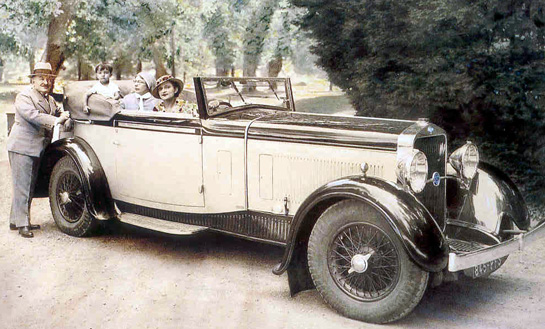
The classic D8 four seater convertible with body by Candelaresi for the famous Chef Vettard of the Place Bellecour in Lyon.
It took a while to really get a grip on France, but by 1933 a major recession was unavoidable. Suddenly it seemed the company was in the wrong business at the wrong time. Only 1902 D8s of all types were made, while frantic attempts to introduce new and less expensive models failed to stem the tide of losses. Banks called on loans that could not be repaid. Sales fell even further and stocks of cars piled up. A subscription bond was issued but failed to raise enough money to repay the bank loans. On April 16, 1935, Louis Delage gave up and the firm went into voluntary liquidation.
An attempt by a prominent Delage dealer and businessman Walter Watney to save the company was put in place and while it served a purpose, eventually a badge-engineering deal was made with Delahaye and Watney later sold all his rights to the Delage brand.
When Delage is a Delahaye
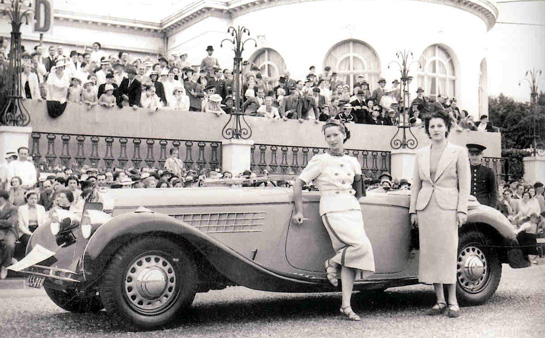
Now not much more than a re-badged Delahaye, the D8 continued to be the favorite of concours and coachbuilders like Figoni et Falaschi, as shown here. MME Carlo Rim at Deauville in 1936.
Essentially, from 1936 on, Delages were assembled at Delahaye, equipped with chassis provided by Delahaye, and a range of engines based in part on a Delahaye design. However, the six and eight cylinder engines that powered the Delages from 1936 on were more Delahaye than Delage. That left the hood, badge and grille to be claimed for Delage. A separate company, formed by Watney, was set up to assist in the sale and marketing of the Delage brand via existing dealerships.
Even the classic D8 Delage of 1929 was replaced by a Delahaye designed straight eight; most of the luxury cars used a Cotal gearbox. But the name remained, so strong was the tradition of excellence established by Delage that the brand lived on, more or less, until 1954, when Delahaye itself was no more.
